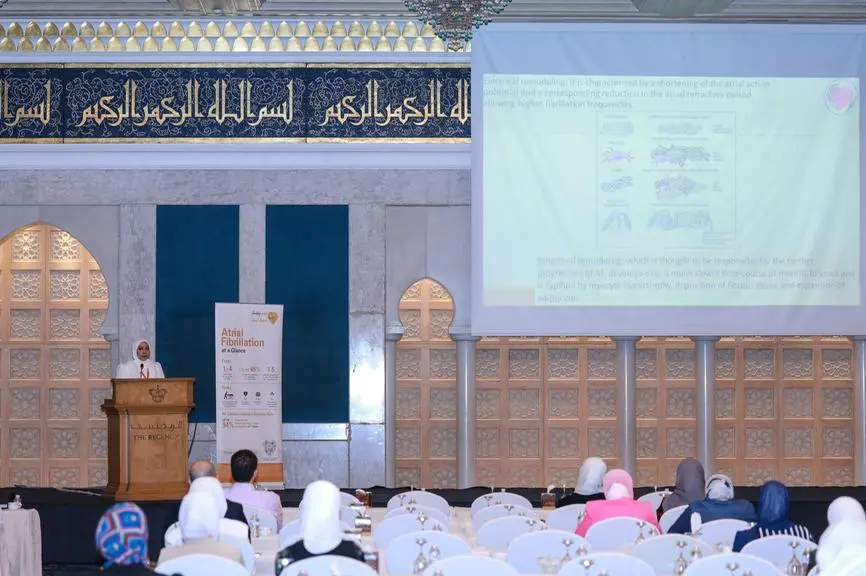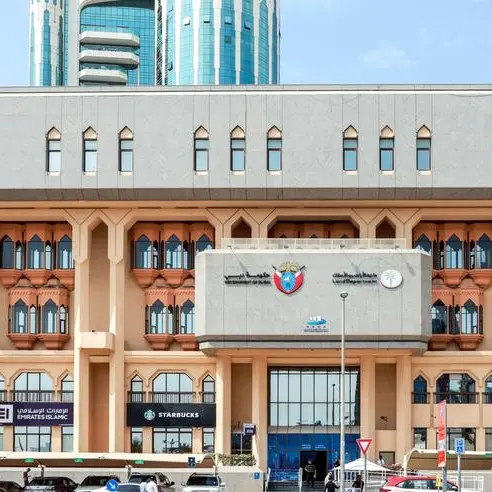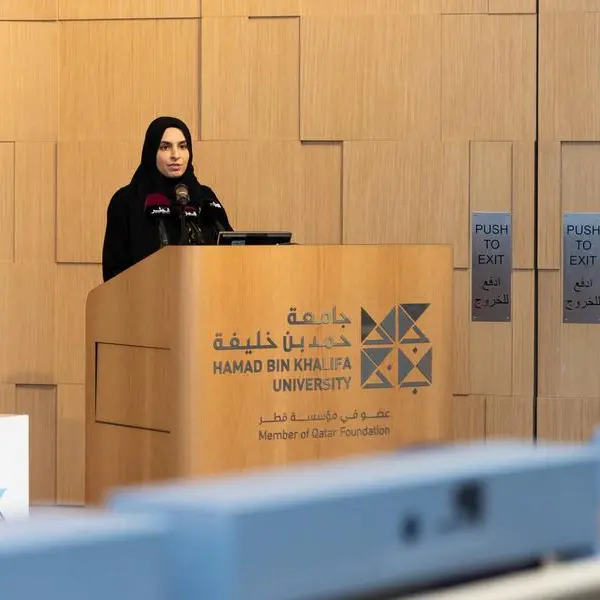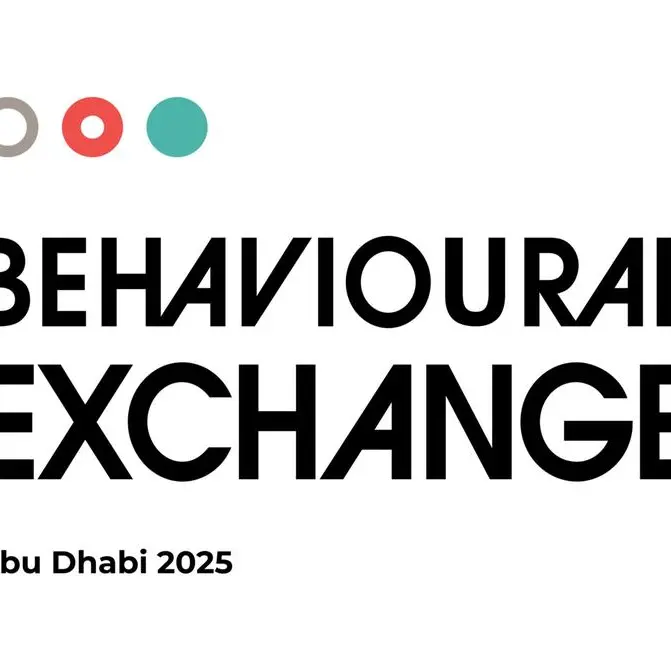PHOTO
Atrial Fibrillation symposium in Kuwait
- AFiB condition affects 40mn people worldwide; predicted to rise further by 2030³
Kuwait: The first-of-its-kind multidisciplinary Atrial Fibrillation [AFiB] Symposium in Kuwait called for a focused dialogue and the need to augment additional resources to support the education and detection campaigns on the life-threatening Atrial Fibrillation condition that impacts nearly 40 million people globally.¹
The symposium, organized at The Regency Convention Center Kuwait City represents a collaboration between Dr. Samah AlKharji, Heart Rhythm Specialist Head of Department of Cardiology at Dabbous Cardiac Center, Adan Hospital, and Biosense Webster ME – part of Johnson & Johnson MedTech Family of Companies, which brought together over 75 participants representing different cardiac specialties to discuss ways to tackle AFiB.
AFiB is the most common type of cardiac arrhythmia and about one in four adults over the age of 40 are at risk of developing AFiB² Despite these projections, many people in the region and beyond are unfamiliar with AFiB symptoms, available treatment options, and the importance of early treatment to avoid disease progression.
The symposium in Kuwait, which took place recently, was organized as part of the AFiB Awareness Month and focused on addressing the epidemic which has doubled in prevalence in the past decade and is predicted to rise further by 2030.³ The objectives of the AFiB Awareness Month are focused on generating awareness, improving knowledge and encouraging better detection of the condition.
Leading General Practitioners (GPs), internal medicine specialists, cardiologists and electrophysiologists, interventional cardiologists, haematology, neurology, and pulmonology experts attended the symposium and shared their knowledge on the importance of early detection, risk factors, treatment options, guidelines for managing AFiB as well as the resources for both healthcare professionals and patients to support education and detection.
Dr. Samah AlKharji, Heart Rhythm Specialist and Head of Department of Cardiology at Dabbous Cardiac Center, Adan Hospital: “We are seeing more cases of Atrial Fibrillation as its prevalence increases with age, affecting one in four people over 40, and this rise is partly due to ageing population. However, we are also seeing a higher prevalence of risk factors for developing AFiB, such as diabetes, hypertension and obesity. The AFiB Awareness Month aims to detect cases of AFiB at an earlier stage to avoid serious complications such as stroke, giving our patients the potential for better health outcomes.“
“We need to work together as a community to tackle the challenge of AFiB, now recognized as a major public health condition with high comorbidity and increased mortality. Cardiologists, together with General Practitioners, play a vital role in supporting patients through the pathway to early diagnosis, intervention and optimal management. That is why providing a platform to share important scientific information, newest guidelines and tools is essential to enhance early referral and effective care to counter AFiB.”
Early diagnosis and intervention are key to optimal and prompt treatment to reduce both the patient burden and the impact of AFiB on healthcare resources. The burden of AFiB needs to be tackled by a multi-disciplinary approach that involves patients, GPs, cardiologists and electrophysiologists, working together to support the treatment pathway.
Doaa Ebada, Business Unit Director of Cardio Vascular and Specialty Solutions ME – part of Johnson & Johnson MedTech Family of Companies, said: “For over 20 years, Biosense Webster has led the science of diagnosing and treating heart rhythm disorders. We have partnered with clinicians to develop innovative technologies that improve the quality of care for arrhythmia patients worldwide and we remain committed to the cause. We can all work together to tackle the condition head-on and heal more hearts. We are proud to be the be the partners in such scientific symposium in Kuwait to support better knowledge and action about AFiB.
AFiB can cause debilitating symptoms such as breathlessness, palpitations and chest pains which may significantly impact patients’ quality of life. ³,⁷ It also increases the risks of more serious conditions such as heart failure and stroke and can also result in sudden death.³,⁹ Up to 30% of all strokes are AFiB-related and are often more severe, or even fatal, than non-AFiB related strokes.³,⁹.
.‘Silent AFiB’, where the patient experiences no apparent symptoms, affects up to 30% of people and remains a clinical challenge. ⁷,¹⁰ These cases need to be uncovered either through health screening or through a patient’s own pulse check. AFiB is then confirmed by a physician, most commonly through an Electrocardiogram (ECG) test.
When AFiB is diagnosed there is a range of management and treatment options available which also include stroke prevention therapies, heart rate and rhythm control drugs. Non-drug intervention, using catheter ablation, has become a more widely performed procedure to prevent recurrent AFiB¹²
Catheter ablation is a safe and effective procedure to restore the heart’s incorrect electrical signals, which causes abnormal heart rhythm.¹³ The quality of life has been shown to improve after catheter ablation compared to drug treatment for AFiB.¹⁴ Among patients with symptomatic AFiB, catheter ablation, compared with medical therapy, led to clinically important and significant improvements in quality of life at 12 months.¹³ In addition to potentially improving well-being, the procedure can reduce several life-threatening conditions associated with AFiB, including stroke. ³These findings can help guide decisions regarding management of AFiB.
-Ends-
About Atrial Fibrillation
Atrial Fibrillation [AFiB] is the most common form of cardiac arrhythmia and is characterised by an irregular and often fast heartbeat that results in uncoordinated contraction of the top two chambers of the heart (i.e. atria).¹⁵ It occurs when there is a fault in the electrical activity of the heart, causing the heart to beat in an irregular and uncoordinated fashion.¹⁶ It is typically a progressive condition, with one in five progressing from paroxysmal (intermittent) to persistent (constant) AFiB within 1 year.¹⁷ The symptoms of AFiB can have a devastating impact on those affected, with up to 47% of patients experiencing a reduction in their overall quality of life.¹⁸–²⁰
About Biosense Webster
Biosense Webster is the global market leader in the science and technology behind the diagnosis and treatment of cardiac arrhythmias. Part of the Johnson & Johnson MedTech Family of Companies, the specialized medical-technology company is headquartered in Irvine, Calif., and works across the world to advance the tools and solutions that help electrophysiologists identify, treat, and deliver care.
About Johnson & Johnson MedTech
At Johnson & Johnson MedTech, we unleash diverse healthcare expertise, purposeful technology, and a passion for people to transform the future of medical intervention and empower everyone to live their best life possible. For more than a century, we have driven breakthrough scientific innovation to address unmet needs and reimagine health. In surgery, orthopaedics, vision, and interventional solutions, we continue to help save lives and create a future where healthcare solutions are smarter, less invasive, and more personalized.
References
- Lippi G, Sanchis-Gomar F, Cervellin G. Global epidemiology of atrial fibrillation: An increasing epidemic and public health challenge. Int J Stroke. 2021 Feb;16(2):217-221. doi: 10.1177/1747493019897870. Epub 2020 Jan 19. Erratum in: Int J Stroke. 2020 Jan 28;:1747493020905964. PMID: 31955707.
- Ball J, Carrington MJ, McMurray JJ, Stewart S (2013) Atrial fibrillation: profile and burden of an evolving epidemic in the 21st century. Int J Cardiol 167 (5): 1807-1824.
- Zoni-Berisso M, Lercari F, Carazza T, Domenicucci S (2014) Epidemiology of atrial fibrillation: European perspective. Clin Epidemiol 6 213-220.
- Lloyd-Jones DM, Wang TJ, Leip EP, Larson MG, Levy D et al. (2004) Lifetime risk for development of atrial fibrillation: the Framingham Heart Study. Circulation 110 (9): 1042-1046.
- Heeringa J, van der Kuip DA, Hofman A, Kors JA, van Herpen G et al. (2006) Prevalence, incidence and lifetime risk of atrial fibrillation: the Rotterdam study. Eur Heart J 27 (8): 949-953.
- Mairesse GH, Moran P, Van Gelder IC et al. (2017) Screening for atrial fibrillation: a European Heart Rhythm Association (EHRA) consensus document endorsed by the Heart Rhythm Society (HRS), Asia Pacific Heart Rhythm Society (APHRS), and Sociedad Latinoamericana de Estimulación Cardíaca y Electrofisiología (SOLAECE). Europace 1;19(10): 1589-162.
- Rienstra M, Lubitz SA, Mahida S, Magnani JW, Fontes JD et al. (2012) Symptoms and functional status of patients with atrial fibrillation: state of the art and future research opportunities. Circulation 125 (23): 2933-2943.
- Odutayo A, Wong CX, Hsiao AJ, Hopewell S, Altman DG et al. (2016) Atrial fibrillation and risks of cardiovascular disease, renal disease, and death: systematic review and meta‐analysis. BMJ. 354 i4482.
- Nieuwlaat R, Prins MH, Le Heuzey JY, Vardas PE, Aliot E et al. (2008) Prognosis, disease progression, and treatment of atrial fibrillation patients during 1 year: follow-up of the Euro Heart Survey on atrial fibrillation. Eur Heart J 29 (9): 1181-1189.
- Boriani G, Laroche C, Diemberger I, Fantecchi E, Popescu MI et al. (2015) Asymptomatic atrial fibrillation: clinical correlates, management, and outcomes in the EORP-AF Pilot General Registry. Am J Med 128 (5): 509-518 e502
- Nieuwlaat R, Prins MH, Le Heuzey JY, Vardas PE, Aliot E et al. (2008) Prognosis, disease progression, and treatment of atrial fibrillation patients during 1 year: follow-up of the Euro Heart Survey on atrial fibrillation. Eur Heart J 29 (9): 1181-1189.
- Calkins H, Hindricks G, Cappato R, Kim YH, Saad EB et al. (2017) 2017 HRS/EHRA/ECAS/APHRS/SOLAECE expert consensus statement on catheter and surgical ablation of atrial fibrillation. Heart Rhythm 14 (10): e275-e444.
- Natale A, Reddy VY, Monir G, Wilber DJ, Lindsay BD, McElderry HT, Kantipudi C, Mansour MC, Melby DP, Packer DL, Nakagawa H. Paroxysmal AF catheter ablation with a contact force sensing catheter: results of the prospective, multicenter SMART-AF trial. Journal of the American College of Cardiology. 2014 Aug 19;64(7):647-56.
- Mark DB, Anstrom KJ, Sheng S, Piccini JP, Baloch KN, Monahan KH, Daniels MR, Bahnson TD, Poole JE, Rosenberg Y, Lee KL, Packer DL; CABANA Investigators. Effect of Catheter Ablation vs Medical Therapy on Quality of Life Among Patients With Atrial Fibrillation: The CABANA Randomized Clinical Trial. JAMA. 2019 Apr 2;321(13):1275-1285. doi: 10.1001/jama.2019.0692. Erratum in: JAMA. 2019 Jun 18;321(23):2370. PMID: 30874716; PMCID: PMC6450275.
- Iaizzo PA (2015). Handbook of Cardiac Anatomy, Physiology, and Devices. Springer Science+Business Media, LLC: Switzerland.
- European Society of Cardiology. European Heart Rhythm Association. Available from www.AFmatters.org/about-atrial-fibrillation last accessed June 2019.
- Nieuwlaat R, Prins MH, Le Heuzey JY, Vardas PE, Aliot E et al. (2008) Prognosis, disease progression, and treatment of atrial fibrillation patients during 1 year: follow-up of the Euro Heart Survey on atrial fibrillation. Eur Heart J 29 (9): 1181-1189.
- Dorian P, Jung W, Newman D, Paquette M, Wood K et al. (2000) The impairment of health-related quality of life in patients with intermittent atrial fibrillation: implications for the assessment of investigational therapy. J Am Coll Cardiol 36 (4): 1303-1309.
- Van den Berg MP, Hassink RJ, Tuinenburg AE, van Sonderen EF, Lefrandt JD et al. (2001) Quality of life in patients with paroxysmal atrial fibrillation and its predictors: importance of the autonomic nervous system. Eur Heart J 22 (3): 247-253.
- Roalfe AK, Bryant TL, Davies MH, Hackett TG, Saba S et al. (2012) A cross-sectional study of quality of life in an elderly population (75 years and over) with atrial fibrillation: secondary analysis of data from the Birmingham Atrial Fibrillation Treatment of the Aged study. Europace 14 (10): 1420-1427.
For more information, please contact:
Bedour Mossa
Public Relations Account Manager
Apco Worldwide
bmossa@apcoworldwide.com




















